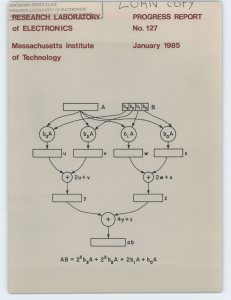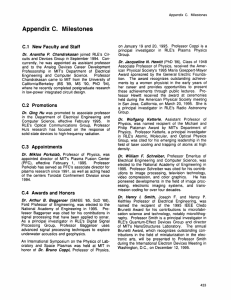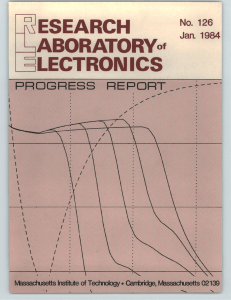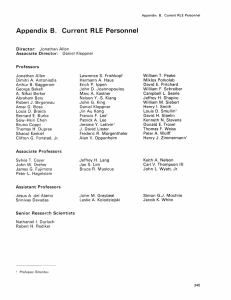MASSCHUET7 INS FTCN LG TITUTE
advertisement
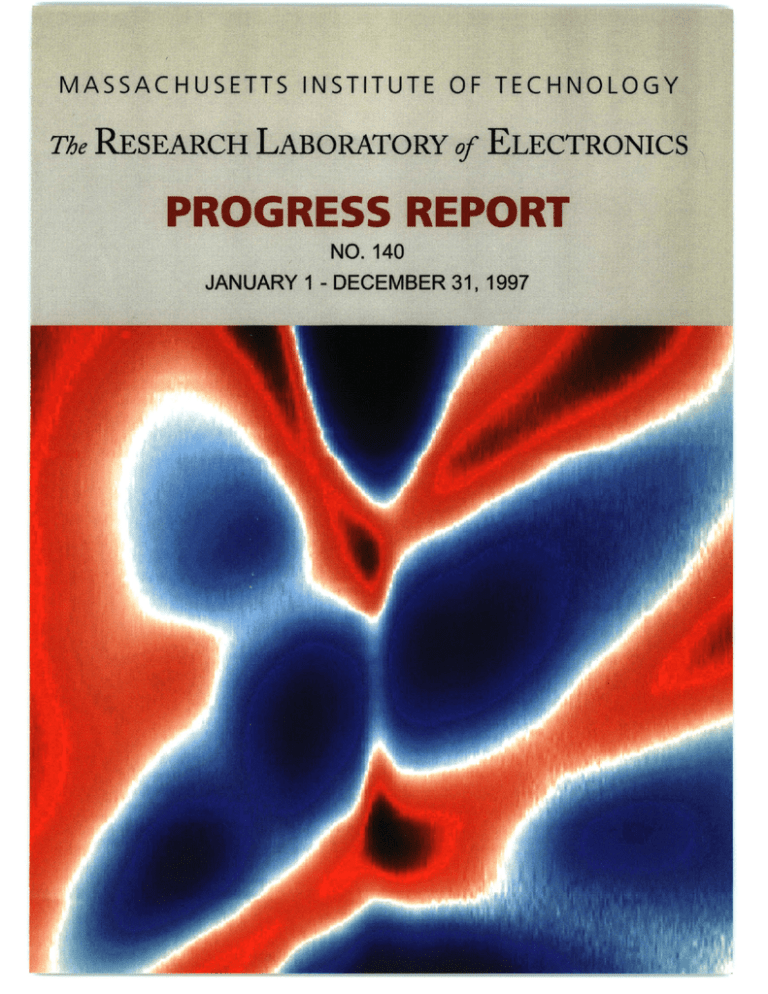
MASSCHUET7 Th REERC INS TITUTE FTCN LG ABRTRYo EETRNC PRGESRPR ~NO JANUAR 4EEBE Ln, A 1 40 119 RLE Progress Report No. 140 January 1 - December 31, 1997 Submitted by Professor Jonathan Allen Professor Daniel Kleppner The RESEARCH LABORATORY of ELECTRONICS MASSACHUSETTS INSTITUTE of TECHNOLOGY CAMBRIDGE, MASSACHUSETTS 02139-4307 RLE Progress Report Number 140 Cover and title page. The Kondo Effect in a Single-Electron Transistor: The Kondo effect occurs when a metal containing a low concentration of magnetic impurity atoms is cooled to a very low temperature (generally a few degrees above absolute zero). At these low temperatures, an unpaired electron on each impurity atom forms a bond (or singlet) with a mobile conduction electron in the metal. An analogous, but much more tunable, system is the single-electron transistor (SET) currently being explored for use in future ultra-miniaturized electronics. In an SET a central droplet of electrons (corresponding to a single impurity atom) interacts with electrons in conducting leads (corresponding to the metal host). A new generation of SETs fabricated at the Weizmann Institute in Israel and studied at MIT has been found to exhibit the Kondo effect. In the cover figure, the conductance of one such SET is plotted in a color scale as a function of the voltage applied to two of its terminals. As electrons are added to the central droplet by applying a gate voltage (vertical on the figure), the droplet alternately behaves as a magnetic impurity (odd number of electrons) or a nonmagnetic impurity (even number). The narrow white vertical line at the center of the figure represents additional current flowing through the SET due to the formation of a Kondo singlet when the central droplet contains an odd number of electrons. It does not extend to the top and bottom of the figure, where the droplet occupancy is even and no current can flow. For more information about the research of Professor Marc A. Kastner, see page 39 of this report. Our special thanks to the following people: Jonah Sacks for organizational support, editing, proofreading, graphics processing, and design assistance; Ahsaki S. Hardy for formatting and inputting information; John F. Cook for photographic assistance; and David J. Goldhaber-Gordon for the cover graphic and description. We also want to thank David W. Foss, RLE Computer Systems Manager, for his time and invaluable technical assistance. We thank the faculty, staff, and students of RLE for their generous cooperation. Editor: Barbara Passero Editorial Assistant: Jonah Sacks Software: The RLE Progress Report was produced using Adobe® FrameMakere 5.5 software. Printer: Lanier Professional Services, Canton, Massachusetts. Copyright © 1998 by the Massachusetts Institute of Technology. All rights reserved. ISSN 0163-9218. The Research Laboratory of Electronics The Research Laboratory of Electronics (RLE) was established in 1946 as the Institute's first interdepartmental laboratory. Originally organized under the joint sponsorship of the Departments of Physics and Electrical Engineering, RLE has broadened its interests to cover a wide range of research. RLE Progress Report RLE Progress Report Number 140 describes research programs at RLE for the period January 1 through December 31, 1997. Each chapter of the Progress Report includes a summary of research efforts for research projects listed. Faculty, research staff, students and others who participated in these projects are identified at the beginning of each project, along with sources of funding. There are four appendices at the end of the report: Appendix A is a bibliography of RLE publications and papers presented by RLE staff during 1997; Appendix B is a roster of current RLE staff; Appendix C is a list of RLE faculty and staff milestones and honors received during 1997; and Appendix D is an index of RLE sponsors. The Project Staff and Subject Index provides additional access to the information in this report. The Progress Report is also available on the World Wide Web at http://rleweb.mit.edu. Professor Jonathan Allen, Director, Research Laboratory of Electronics (Photo by John F Cook) RLE on the World Wide Web RLE has a presence on the World Wide Web (http:// rleweb.mit.edu). The RLE web site features the full text of recent RLE publications, including this Progress Report, RLE currents, and RLE undercurrents. The site also includes an introduction to RLE research and services; information about RLE's history, research groups, and staff; news of RLE events; a history of the Radiation Laboratory (1940-1945); and Building 20 reminiscences and photographs. RLE Publications RLE also publishes RLE currents, a biannual newsmagazine which focuses on RLE research interests; atechnical report series; RLE undercurrents, a newsletter for RLE staff; Speech Group Working Papers; and other information related to the Laboratory. For more information, write: Massachusetts Institute of Technology Research Laboratory of Electronics Communications Office, Room 36-412 77 Massachusetts Avenue Cambridge, Massachusetts 02139-4307 Telephone (617) 253-2566; fax (617) 258-7864 2 RLE Progress Report Number 140
